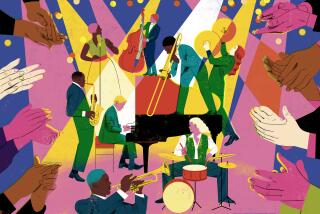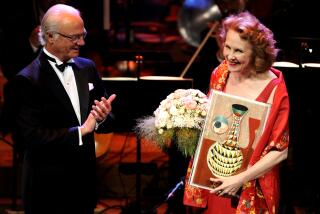JAZZ REVIEW : Stacy Rowles Maintains Those High Standards
HUNTINGTON BEACH â In a solid first set at Maxwellâs Sunday afternoon, fluegelhornist Stacy Rowles proved that ingenuity can cause plenty of excitement.
Working in a low-key manner with a warm, soft tone that sizzled once in a while, Rowles (the daughter of piano notable Jimmy Rowles) roamed the mainstream realm, backed deftly by bassist Jim de Julioâs trio (which included pianist Wally Minko and drummer Jim de Julio Jr).
The musicians played to a sparse crowd, probably because of the earthquakes early that morning; experts had recommended that Southern Californians limit traveling.
But Rowles--casually dressed in a light blue Hawaiian print shirt, faded blue jeans and loafers--seemed unperturbed by the smallness of the audience as she offered such staples as âA Night in Tunisiaâ and a revamped âTake the âAâ Train.â
These warhorses may have been trotted around the block countless times, but the depth and appeal of the compositions, coupled with Rowlesâ inventive approach--her lines were as musical as they were succinct--gave each selection a feeling of freshness.
Rowles opened with âSecret Love,â and in a solo that communicated like a conversation, she closed her eyes and moved from side to side on her stool, playing a variety of contrasting elements, following long, sustained notes with groups of tones that moved like sprinters just out of the blocks. Here as throughout the show, her attractive lines all had a subtle yet firm sense of swing.
Dizzy Gillespieâs âTunisia,â written in 1945, is one of the most durable jazz standards, and Rowles found that its seesawing harmonic platform (the main solo section of the tune alternates between two nearby chords) presented her with an ideal format for improvisation.
She began her solo with a long, quietly squealing note and then dove in, offering short, choppy ideas or long, serpentine ones like the smooth curves of a roller coaster seen from a distance.
Rowles gave âI Fall in Love Too Easilyâ a tender reading, embellishing the melody by approaching it from below or above, or decorating it with attractive figures that seemed to spin like twirlers. She closed the number with a glowing pale-toned vocal that was remarkably unlike her speaking voice.
She outfitted â âAâ Trainâ with a new melody, hitting one tone several times, then doing the same with another tone, then shifting to a flowing line.
In her solo, she played some passages that were fluid and others in which she dragged the notes out as if they were being slowly pulled from a jar.
Pianist Minko, who played with bright effusiveness during two opening numbers by the trio, became more relaxed and worked with a darker sound behind Rowles. His solos, although charged with a compelling aggression, didnât overwhelm but rather provided an alternative to Rowlesâ easy-paced forays.
On âTunisia,â he swung handily, sometimes repeating rhythmically punchy phrases, barely changing them and playing them again; sometimes using all 10 fingers in block chord attacks that created a bouquet of sounds.
As usual, bassist de Julio--who can improvise on his bulky instrument with the grace of a horn player--delivered one choice solo and then another. He cooked on his own blues âChase, No Straighterâ--a takeoff on Thelonious Monkâs âStraight, No Chaser.â
He was persuasive during âTunisia,â plucking the same string several times, developing a thick texture, then segueing into crisply picked patterns or elongating notes like a rubber band. He concluded this improvisation with a note that slid slowly up his instrument, then suddenly plopped down like an apple falling from a tree.
More to Read
The biggest entertainment stories
Get our big stories about Hollywood, film, television, music, arts, culture and more right in your inbox as soon as they publish.
You may occasionally receive promotional content from the Los Angeles Times.










